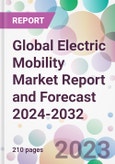According to the report, the global electric mobility market is projected to grow at a CAGR of 20% between 2024 and 2032. Aided by the escalating demand for sustainable transportation solutions and advancements in electric vehicle (EV) technology, the market is expected to grow significantly by 2032.
Electric mobility encompasses a range of electrically-powered vehicles, including electric cars, buses, scooters, and bicycles. These vehicles are central to the global initiative of reducing carbon emissions and mitigating the environmental impact of transportation. The market's expansion is a reflection of the increasing consumer and governmental focus on sustainability, alongside technological advancements in battery efficiency and vehicle performance.
The rapid electric mobility market growth is primarily fuelled by stringent government regulations aimed at reducing greenhouse gas emissions. Many countries have implemented policies promoting the use of electric vehicles, including tax incentives, subsidies, and the development of charging infrastructure. These measures are significantly boosting the adoption of electric vehicles worldwide.
Furthermore, technological advancements in battery technology and electric drivetrains are making electric vehicles more accessible and practical for everyday use. Improvements in battery capacity and efficiency are extending vehicle range, reducing charging times, and lowering costs, thereby enhancing consumer appeal.
The report segments the electric mobility market into various vehicle types, such as electric cars, electric two-wheelers, and electric buses. Among these, electric cars hold a dominant portion of the electric mobility market share, attributed to their increasing popularity in both developed and emerging economies. However, electric two-wheelers and buses are also gaining traction, especially in urban areas where they offer efficient solutions for traffic congestion and air pollution.
Geographically, the market analysis covers regions including North America, Europe, Asia-Pacific, Latin America, and the Middle East and Africa. The Asia Pacific region, particularly China and India, is a major market for electric mobility, driven by large population centres and growing environmental concerns. Europe and North America are also significant markets, with well-established automotive industries and supportive government policies.
The global electric mobility market demand is poised for significant surge over the forecast period, driven by environmental concerns, technological advancements, and supportive government policies. The expansion of this market is vital for the transition towards sustainable transportation, contributing to the global effort to combat climate change and reduce the environmental impact of the transportation sector.
Electric mobility encompasses a range of electrically-powered vehicles, including electric cars, buses, scooters, and bicycles. These vehicles are central to the global initiative of reducing carbon emissions and mitigating the environmental impact of transportation. The market's expansion is a reflection of the increasing consumer and governmental focus on sustainability, alongside technological advancements in battery efficiency and vehicle performance.
The rapid electric mobility market growth is primarily fuelled by stringent government regulations aimed at reducing greenhouse gas emissions. Many countries have implemented policies promoting the use of electric vehicles, including tax incentives, subsidies, and the development of charging infrastructure. These measures are significantly boosting the adoption of electric vehicles worldwide.
Furthermore, technological advancements in battery technology and electric drivetrains are making electric vehicles more accessible and practical for everyday use. Improvements in battery capacity and efficiency are extending vehicle range, reducing charging times, and lowering costs, thereby enhancing consumer appeal.
The report segments the electric mobility market into various vehicle types, such as electric cars, electric two-wheelers, and electric buses. Among these, electric cars hold a dominant portion of the electric mobility market share, attributed to their increasing popularity in both developed and emerging economies. However, electric two-wheelers and buses are also gaining traction, especially in urban areas where they offer efficient solutions for traffic congestion and air pollution.
Geographically, the market analysis covers regions including North America, Europe, Asia-Pacific, Latin America, and the Middle East and Africa. The Asia Pacific region, particularly China and India, is a major market for electric mobility, driven by large population centres and growing environmental concerns. Europe and North America are also significant markets, with well-established automotive industries and supportive government policies.
The global electric mobility market demand is poised for significant surge over the forecast period, driven by environmental concerns, technological advancements, and supportive government policies. The expansion of this market is vital for the transition towards sustainable transportation, contributing to the global effort to combat climate change and reduce the environmental impact of the transportation sector.
Market Segmentation
The market can be divided based on type, vehicle type, component, and region.Market Breakup by Type
- Battery Operated Electric Vehicle
- Plug-in Hybrid Electric Vehicle
- Hybrid Electric Vehicle
Market Breakup by Vehicle Type
- Passenger Electric Vehicle
- Commercial Electric Vehicle
Market Breakup by Component
- Electric Motor
- Battery
- Others
Market Breakup by Region
- North America
- Europe
- Asia Pacific
- Latin America
- Middle East and Africa
Competitive Landscape
The report looks into the market shares, plant turnarounds, capacities, investments, and mergers and acquisitions, among other major developments, of the leading companies operating in the global electric mobility market. Some of the major players explored in the report are as follows:- Nissan Motor Co., Ltd
- Tesla, Inc. (NASDAQ: TSLA)
- Toyota Motor Corporation
- Groupe Renault
- General Motors
- Ford Motor Company
- Others
Table of Contents
1 Preface2 Report Coverage - Key Segmentation and Scope4 Key Assumptions7 Opportunities and Challenges in the Market15 Value Chain Analysis17 Key Trends and Developments in the Market
3 Report Description
5 Executive Summary
6 Snapshot
8 Global Electric Mobility Market Analysis
9 North America Electric Mobility Market Analysis
10 Europe Electric Mobility Market Analysis
11 Asia Pacific Electric Mobility Market Analysis
12 Latin America Electric Mobility Market Analysis
13 Middle East and Africa Electric Mobility Market Analysis
14 Market Dynamics
16 Competitive Landscape
List of Key Figures and Tables
Companies Mentioned
- Nissan Motor Co. Ltd
- Tesla Inc. (NASDAQ: TSLA)
- Toyota Motor Corporation
- Groupe Renault
- General Motors
- Ford Motor Company
Methodology

LOADING...








